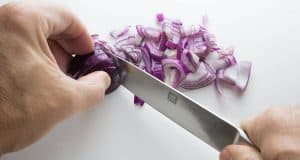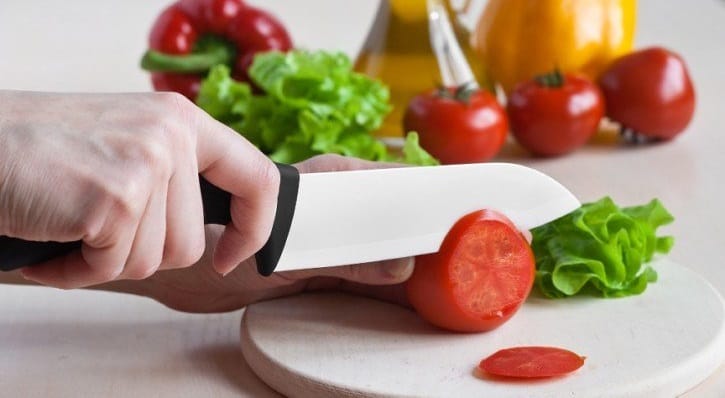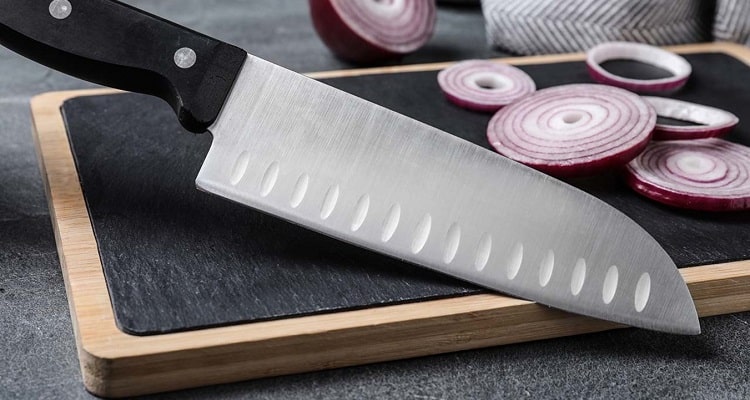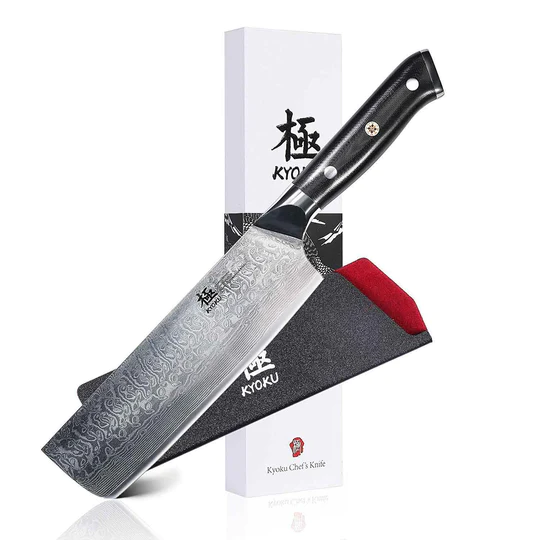


If you’ve ever wondered if ceramic knives are better than steel knives, you’re not alone. Many people look for the sharpest, easiest-to-use knife for their kitchens, but they don’t know if ceramic blades are reliable or not.
Ceramic knives stay sharper longer and they don’t rust. But you also risk chipping or breaking the blade if you drop it, or twist while cutting.
Steel knives can handle a wider variety of tasks and you can easily sharpen them, even if they get dull with use. Knowing what you need from a knife makes it easier to choose the best type for your kitchen.
Ceramic and steel knives are made from very different materials and perform best in different situations. Knowing how they compare can help you pick the best kitchen knife for your needs.
| Feature | Ceramic Knives | Steel Knives |
|---|---|---|
| Sharpness | Very sharp, keeps edge longer | Sharp, needs care |
| Weight | Very light | Heavier |
| Durability | Brittle, can chip or break | Strong, less likely to break |
| Care Needed | Hard to sharpen at home | Easy to sharpen |
| Best Uses | Fruits and veggies | All foods, including meat and bone |
The main difference between ceramic and steel knives is blade hardness. Ceramic knives are much harder than steel knives. Their edges stay sharp for a long time and don’t wear down as fast as steel.
Ceramic knives are made from hard materials like zirconium oxide while metal knives are made from carbon steel, stainless steel, and Damascus steel alloys.
Ceramic knives hold their sharp edge for a long time. You spend less time sharpening and more time cooking. Their surfaces are non-reactive, so they don’t stain or transfer flavors between foods.
Because they are lightweight, ceramic knives are comfortable to use for long periods. They work well for slicing fruits and vegetables cleanly. Their hard, smooth blades are also easy to rinse off.
Ceramic knives do not rust, which can be a major advantage in wet environments like kitchens. However, you should avoid using them on frozen foods or anything with bones as the blades may chip.
Steel knives can handle a much wider range of tasks. You can cut through bones, frozen foods, or thick rinds without worrying about breaking the blade. This toughness makes steel knives reliable for most kitchen work.
They come in many styles, including flexible boning knives, heavy cleavers, and fine paring knives. With proper care, high-quality stainless steel knives can last for decades.
You can easily sharpen steel knives at home with a regular sharpening stone or honing rod. They also offer more grip and weight, which some cooks prefer for control and safety. Stainless steel resists rust and stains, making care easier.
Ceramic and steel knives work differently in the kitchen. How they cut, last, and feel in your hand often comes down to the materials used in the blade and handle.
Ceramic knives are very sharp out of the box. The ceramic material is harder than steel, which helps the edge stay keen for a long time with normal use. You can cut soft fruits, vegetables, and boneless meats with less effort, making your prep work smooth.
You might find that ceramic knives stay sharper longer. These blades don’t rust or stain, which helps keep the edge clean, but if they chip, you may need to get a new knife. Ceramic knives also need special equipment and skill to sharpen.
Steel knives start off sharp, but they may lose their edge faster and need more frequent sharpening. You can easily restore that sharp edge using a simple sharpening tool at home.
However, you need to factor in the cost of buying a decent knife sharpener, knife oil, and other accessories to help maintain the knife edge.
Ceramic knives are strong against wear but brittle. They work well for slicing softer foods, but cutting hard objects can chip the blade. Dropping a ceramic knife on a hard floor may also break the blade.
Steel knives are tougher and more flexible. If you need to chop, pry, or cut something hard, steel is much less likely to break. Steel can bend a little without breaking, while ceramic blades do not bend at all. For jobs that need more force or strength, steel knives outperform ceramic.
If you plan to use your knife for more than slicing soft foods, a steel knife is less likely to get damaged.

Ceramic knives are light to hold compared to steel knives. Some people prefer lightweight knives for quick, precise cuts. You may also notice less fatigue in your hands when prepping large amounts of food. This is because the lighter blade is easier to handle.
Steel knives are heavier, and the extra weight can help when you need more force for chopping through hard root vegetables and large pieces of meat. The design of steel knives can vary widely. Some have ergonomic handles or textured grips for comfort and safety.
Most ceramic knives have simple, sleek designs with smooth blades and handles. This makes cleaning easy, but if you want a knife with more grip or a specialized handle, you will find better options with steel knives.
Steel knives are more versatile for many kitchen tasks. You can use them for slicing meat, dicing vegetables, and even cutting through bone or tough foods. Their strength allows for twisting, rocking, and various cutting styles. Steel blades also come in many shapes and sizes, letting you choose the right knife for each job.
Ceramic kitchen knives are best for slicing fruits, vegetables, and soft, boneless meat. They do not rust, and food doesn’t easily stick to the blade. However, ceramic blades are brittle. Avoid using them on frozen food, hard cheese, or bones, as they may chip or break. If you want one knife for everything, steel knives are less risky. If you want a sharp, lightweight blade for certain tasks, ceramic is a good fit.
Many home cooks enjoy ceramic knives for their lightness and easy handling. You may notice your hands tire less during long prep sessions. For people who prepare a lot of salads or fruit, ceramic offers clean, precise cuts.
Most professional chefs use steel knives. They rely on tools that handle various foods and cutting techniques. Steel knives can be sharpened often and adapted to any dish. In a busy kitchen, dropping a knife is common, and a ceramic knife is likely to chip or break in these situations. Professional kitchens usually need the flexibility, durability, and adaptability that steel provides.

Ceramic and steel knives have important differences in sharpness, strength, and care. Their uses, maintenance, and performance set them apart in home and professional kitchens.
Professional chefs often prefer steel knives because they are strong and durable. You can use them on a wider variety of foods, including bones and frozen ingredients. Steel knives are also easier to sharpen and maintain during long shifts.
Ceramic knives are brittle and can chip or break easily if dropped or used on hard objects. Do not use them to cut bones, frozen foods, or other hard ingredients.
They are best for slicing soft items like fruits, vegetables, and boneless meats.
A ceramic knife’s blade usually stays sharp longer than a basic steel knife. Some ceramic blades last up to 11 times longer than some steel blades before they need sharpening.
Ceramic knives do not rust and are easy to clean. However, sharpening them at home is very hard, and you need special tools. If you chip a ceramic blade, repairing it is difficult or impossible.
Steel knives need to stay dry to prevent rust. You can sharpen them easily at home using common sharpening tools.
Ceramic knives are not suitable for every kitchen job. Do not use them for chopping bones, frozen food, or other tough items.
They work best for slicing and cutting softer foods.
Steel knives are more versatile and handle a wider range of tasks. You can use them for chopping, deboning, and cutting tough foods.
Ceramic knives are lighter and stay sharp for a long time, but they do not perform well when you need strength or flexibility.

Both ceramic and steel knives are affordable, deliver precision cutting, and come in a range of designs.
Ceramic knives are light, sharp, and resist rust. They work well for slicing fruits, vegetables, and boneless meats. These knives do not react with food, so flavors and smells stay true.
Steel knives are tougher and handle a wider variety of cutting tasks. You can use them to cut through bones and tough foods. You can also sharpen steel knives at home to maintain their edge. If you are looking for trusted hardness for demanding cutting tasks a quality steel blade is your best option.

Knife Buzz offers independent product reviews on a wide range of knives used in the kitchen, home, and outdoors. We make it easy for you to find the right knife at the best price.

Knife Buzz offers independent product reviews on a wide range of knives used in the kitchen, home, outdoors and at work.
The Knife Buzz Team are passionate about reviewing knives and we cater to a targeted audience that needs independent advice before purchasing.
KnifeBuzz.com may earn affiliate commissions on some pages of this website. Knife Buzz is a participant in the Amazon Services LLC Associates Program, an affiliate advertising program designed to provide a means for sites to earn advertising fees by advertising and linking to Amazon.com. Amazon and the Amazon logo are trademarks of Amazon.com, Inc, or its affiliates. When you click links to various merchants on this site and make a purchase, this can result in this site earning a commission. Other affiliate programs and affiliations include, but are not limited to, Google AdSense.